Abstract
Anti-Tac(Fv)-PE40 is a recombinant single-chain immunotoxin containing the heavy and light variable regions of the anti-Tac monoclonal antibody fused to a mutant form of Pseudomonas exotoxin (PE). Anti-Tac binds to the p55 subunit of the human interleukin 2 (IL-2) receptor, and anti-Tac(Fv)-PE40 kills human or monkey cell lines that contain either the intact IL-2 receptor or its p55 subunit alone. To assess the usefulness of anti-Tac(Fv)-PE40 in treatment of IL-2 receptor-positive leukemia, we tested peripheral blood mononuclear cells from six patients with adult T-cell leukemia. In each of the six patients, anti-Tac(Fv)-PE40 was extremely cytotoxic to the malignant cells. Metabolic activity and sensitivity of the fresh cells improved when a small amount of IL-2 (10 units per ml) was present during incubation. The toxin concentration necessary to inhibit protein synthesis by 50% after 16-hr incubation of cells with immunotoxin varied from 1.6 to 16 ng/ml (2.5-25 x 10(-11) M). In every case, binding was by means of the Tac antigen because anti-Tac(Fv)-PE40 cytotoxicity was prevented by adding excess anti-Tac antibody. Moreover, anti-Tac alone or an inactive mutant of anti-Tac(Fv)-PE40 without ADP-ribosylation activity had very little cytotoxic activity. Peripheral blood mononuclear cells from normal controls, from a patient with Tac-negative leukemia, and from adult T-cell leukemia patients without significant peripheral blood involvement were not sensitive to anti-Tac(Fv)-PE40. These results indicate that anti-Tac(Fv)-PE40 is a potent cytotoxin against adult T-cell leukemia cells in vitro and warrants clinical testing.
Full text
PDF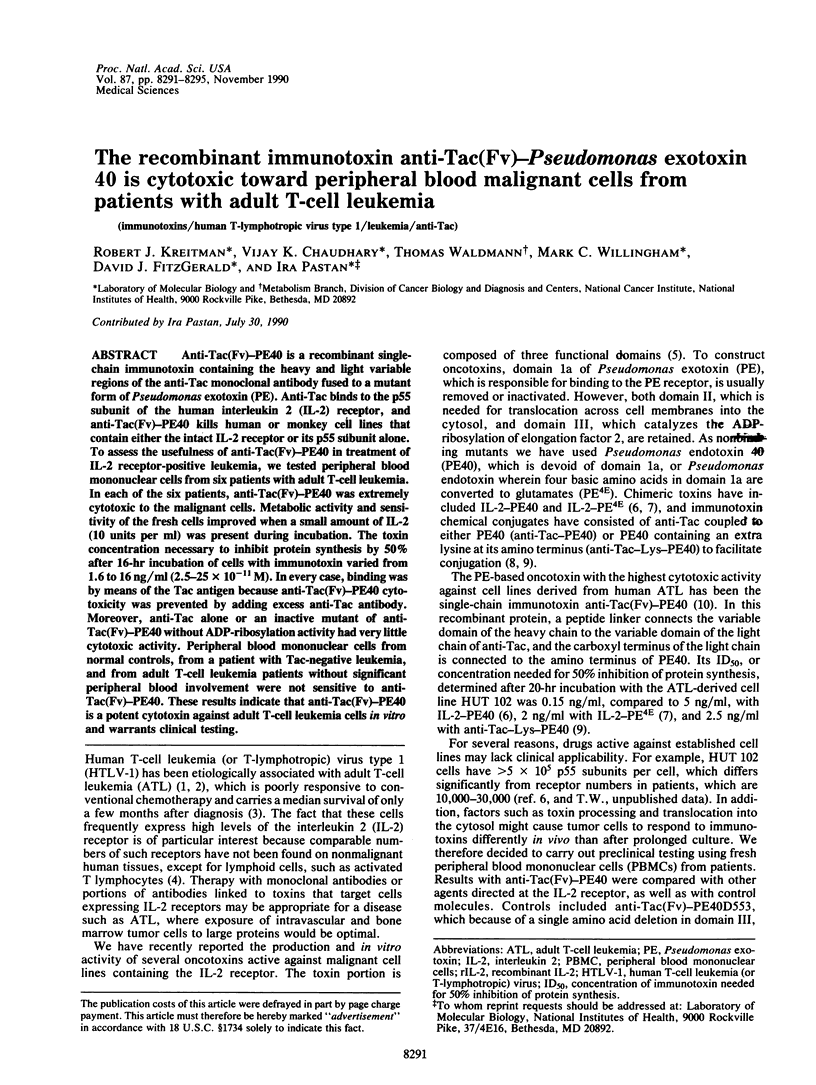
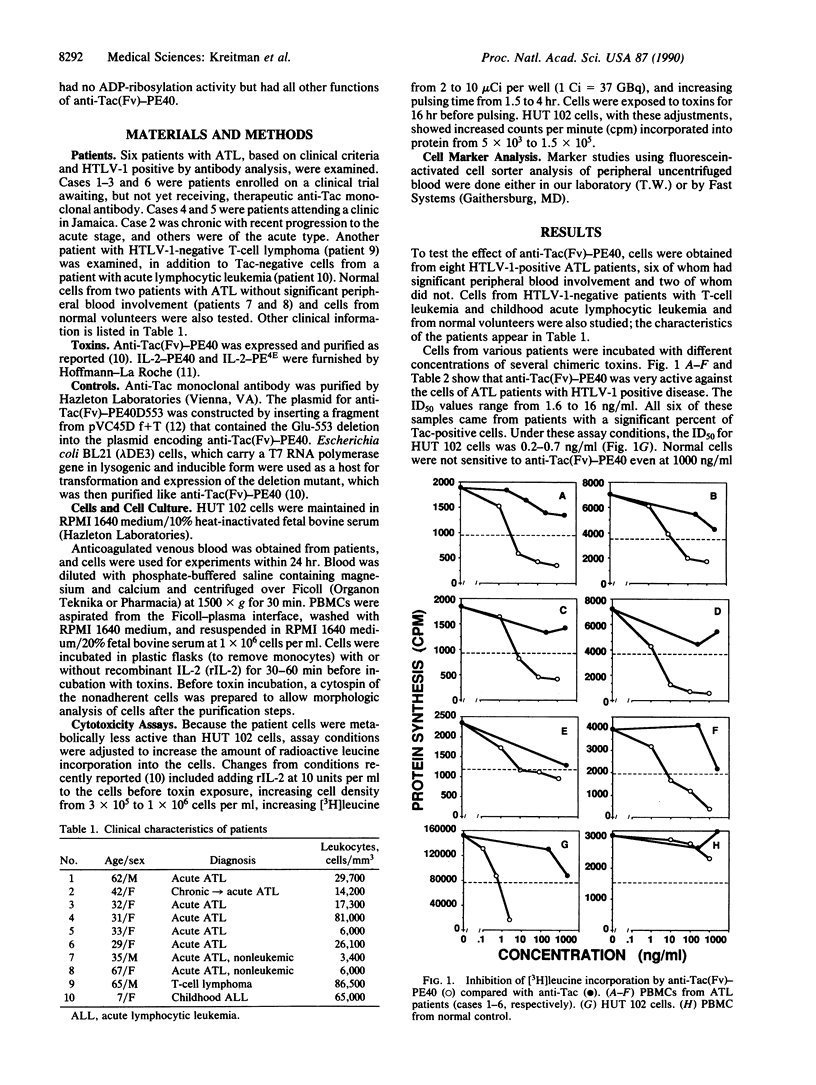
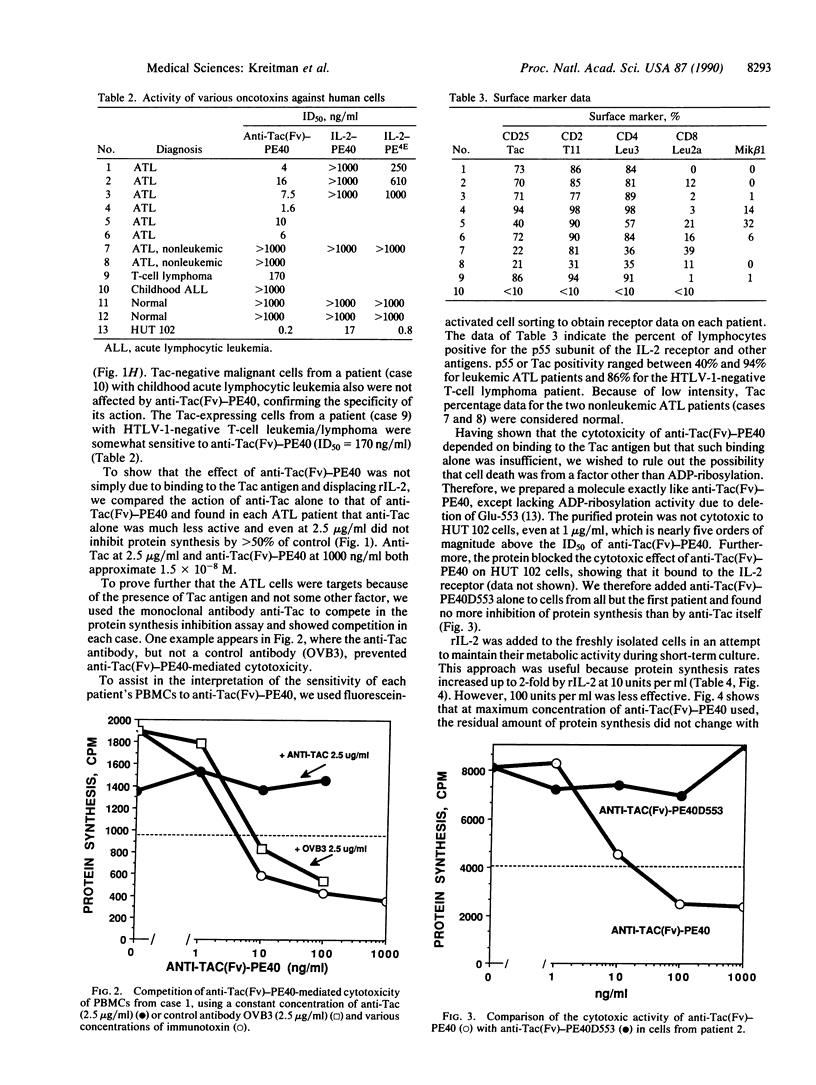
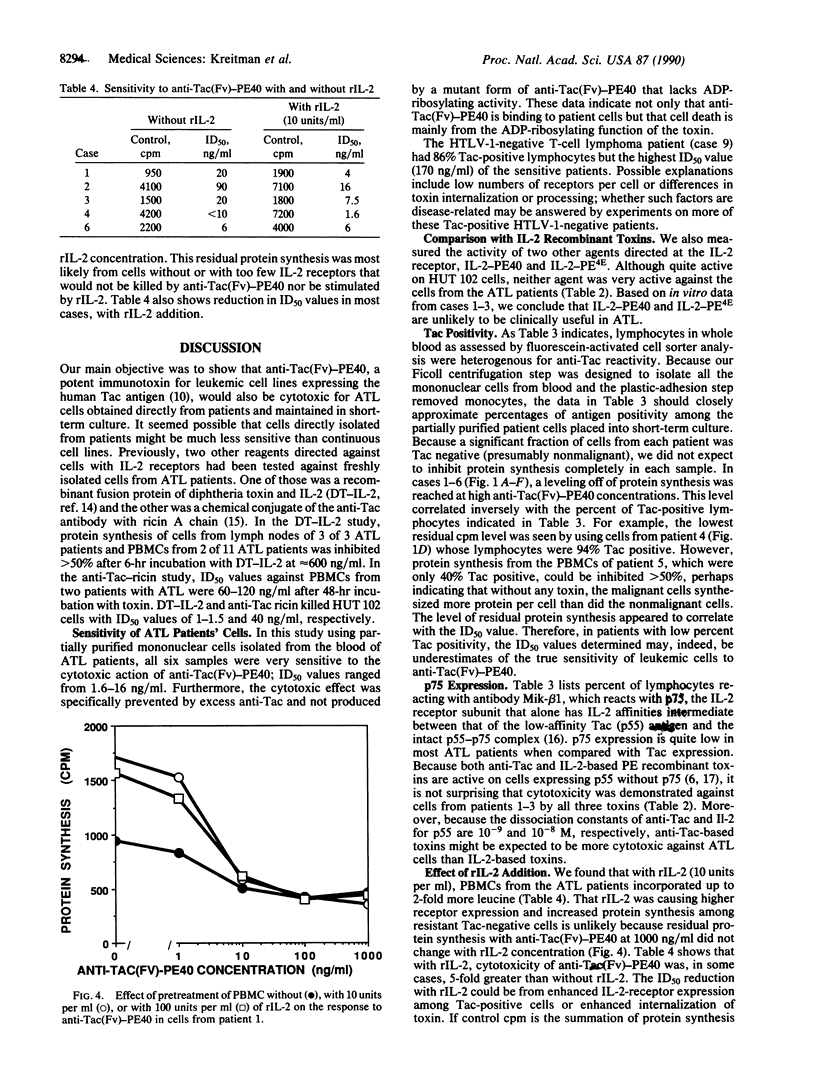
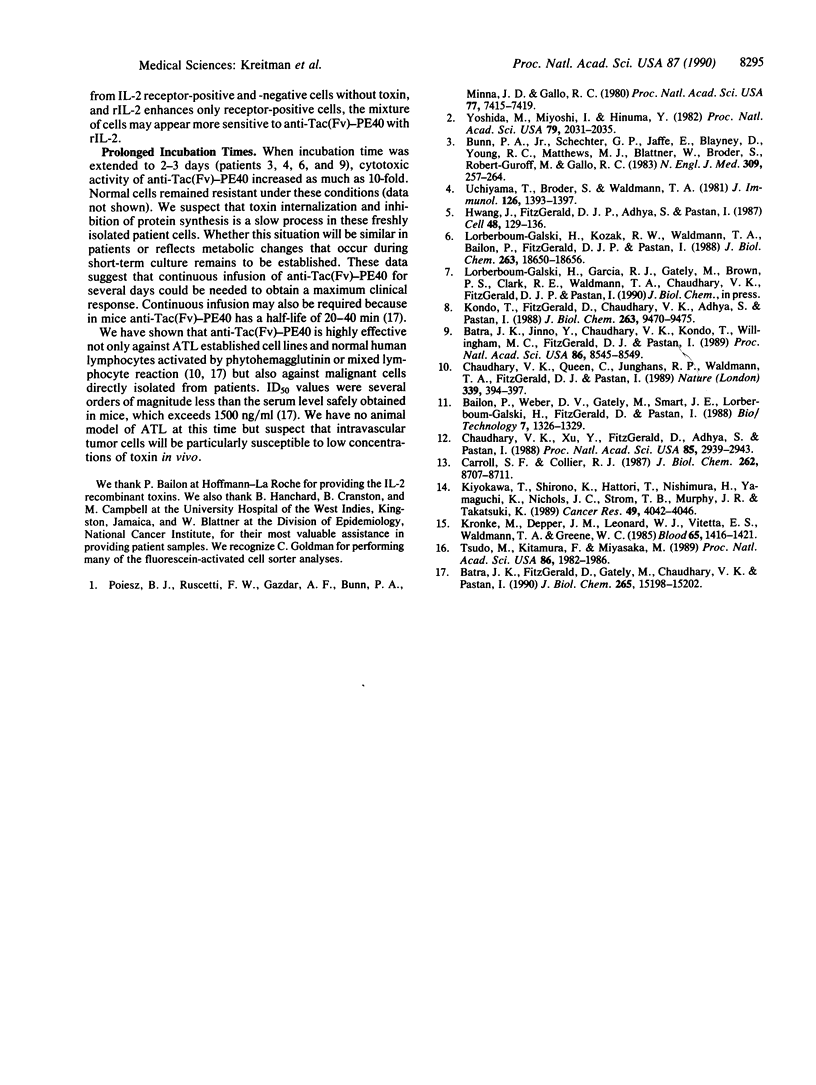
Selected References
These references are in PubMed. This may not be the complete list of references from this article.
- Batra J. K., FitzGerald D., Gately M., Chaudhary V. K., Pastan I. Anti-Tac(Fv)-PE40, a single chain antibody Pseudomonas fusion protein directed at interleukin 2 receptor bearing cells. J Biol Chem. 1990 Sep 5;265(25):15198–15202. [PubMed] [Google Scholar]
- Batra J. K., Jinno Y., Chaudhary V. K., Kondo T., Willingham M. C., FitzGerald D. J., Pastan I. Antitumor activity in mice of an immunotoxin made with anti-transferrin receptor and a recombinant form of Pseudomonas exotoxin. Proc Natl Acad Sci U S A. 1989 Nov;86(21):8545–8549. doi: 10.1073/pnas.86.21.8545. [DOI] [PMC free article] [PubMed] [Google Scholar]
- Bunn P. A., Jr, Schechter G. P., Jaffe E., Blayney D., Young R. C., Matthews M. J., Blattner W., Broder S., Robert-Guroff M., Gallo R. C. Clinical course of retrovirus-associated adult T-cell lymphoma in the United States. N Engl J Med. 1983 Aug 4;309(5):257–264. doi: 10.1056/NEJM198308043090501. [DOI] [PubMed] [Google Scholar]
- Carroll S. F., Collier R. J. Active site of Pseudomonas aeruginosa exotoxin A. Glutamic acid 553 is photolabeled by NAD and shows functional homology with glutamic acid 148 of diphtheria toxin. J Biol Chem. 1987 Jun 25;262(18):8707–8711. [PubMed] [Google Scholar]
- Chaudhary V. K., Queen C., Junghans R. P., Waldmann T. A., FitzGerald D. J., Pastan I. A recombinant immunotoxin consisting of two antibody variable domains fused to Pseudomonas exotoxin. Nature. 1989 Jun 1;339(6223):394–397. doi: 10.1038/339394a0. [DOI] [PubMed] [Google Scholar]
- Chaudhary V. K., Xu Y. H., FitzGerald D., Adhya S., Pastan I. Role of domain II of Pseudomonas exotoxin in the secretion of proteins into the periplasm and medium by Escherichia coli. Proc Natl Acad Sci U S A. 1988 May;85(9):2939–2943. doi: 10.1073/pnas.85.9.2939. [DOI] [PMC free article] [PubMed] [Google Scholar]
- Hwang J., Fitzgerald D. J., Adhya S., Pastan I. Functional domains of Pseudomonas exotoxin identified by deletion analysis of the gene expressed in E. coli. Cell. 1987 Jan 16;48(1):129–136. doi: 10.1016/0092-8674(87)90363-1. [DOI] [PubMed] [Google Scholar]
- Kiyokawa T., Shirono K., Hattori T., Nishimura H., Yamaguchi K., Nichols J. C., Strom T. B., Murphy J. R., Takatsuki K. Cytotoxicity of interleukin 2-toxin toward lymphocytes from patients with adult T-cell leukemia. Cancer Res. 1989 Jul 15;49(14):4042–4046. [PubMed] [Google Scholar]
- Kondo T., FitzGerald D., Chaudhary V. K., Adhya S., Pastan I. Activity of immunotoxins constructed with modified Pseudomonas exotoxin A lacking the cell recognition domain. J Biol Chem. 1988 Jul 5;263(19):9470–9475. [PubMed] [Google Scholar]
- Krönke M., Depper J. M., Leonard W. J., Vitetta E. S., Waldmann T. A., Greene W. C. Adult T cell leukemia: a potential target for ricin A chain immunotoxins. Blood. 1985 Jun;65(6):1416–1421. [PubMed] [Google Scholar]
- Lorberboum-Galski H., Kozak R. W., Waldmann T. A., Bailon P., FitzGerald D. J., Pastan I. Interleukin 2 (IL2) PE40 is cytotoxic to cells displaying either the p55 or p70 subunit of the IL2 receptor. J Biol Chem. 1988 Dec 15;263(35):18650–18656. [PubMed] [Google Scholar]
- Poiesz B. J., Ruscetti F. W., Gazdar A. F., Bunn P. A., Minna J. D., Gallo R. C. Detection and isolation of type C retrovirus particles from fresh and cultured lymphocytes of a patient with cutaneous T-cell lymphoma. Proc Natl Acad Sci U S A. 1980 Dec;77(12):7415–7419. doi: 10.1073/pnas.77.12.7415. [DOI] [PMC free article] [PubMed] [Google Scholar]
- Tsudo M., Kitamura F., Miyasaka M. Characterization of the interleukin 2 receptor beta chain using three distinct monoclonal antibodies. Proc Natl Acad Sci U S A. 1989 Mar;86(6):1982–1986. doi: 10.1073/pnas.86.6.1982. [DOI] [PMC free article] [PubMed] [Google Scholar]
- Uchiyama T., Broder S., Waldmann T. A. A monoclonal antibody (anti-Tac) reactive with activated and functionally mature human T cells. I. Production of anti-Tac monoclonal antibody and distribution of Tac (+) cells. J Immunol. 1981 Apr;126(4):1393–1397. [PubMed] [Google Scholar]
- Yoshida M., Miyoshi I., Hinuma Y. Isolation and characterization of retrovirus from cell lines of human adult T-cell leukemia and its implication in the disease. Proc Natl Acad Sci U S A. 1982 Mar;79(6):2031–2035. doi: 10.1073/pnas.79.6.2031. [DOI] [PMC free article] [PubMed] [Google Scholar]


